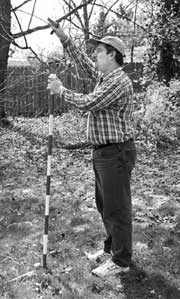                                       |
|
Scientists
search for cause of holes on ‘golf course’
 |
|
Geologist Greg Schumacher, preparing to run a
test on the Antioch College ‘golf course’ last week.
PHOTO BY DIANE CHIDDISTER
|
Holes in the Antioch
College “golf course” — which seem to indicate a previously
unknown underground cave system — have enlarged in the past few months,
and a few more holes have been discovered, according to Peter Townsend,
Antioch College professor of geology and environmental science. However,
the ground has collapsed at a slower pace than anticipated, he said.
“Last fall the holes developed rapidly but it doesn’t appear
that new ones are developing as fast as we first worried they might,”
said Townsend, who in December encouraged local residents to use caution
when walking across the golf course. “But you always want to err
on the side of caution. It’s still a real danger.”
Last week, three geologists from the Ohio Department of Natural Resources
(ODNR) conducted a study to help determine whether there is, in fact,
a cave system under the golf course. The geologists said that results
of the study will be available by the end of this week.
In November, Townsend became aware of three mysterious holes in the golf
course, which appeared to be caused by Karst, or cave system, collapse.
Alerted by villager Corine Pelzl to the holes, Townsend identified one
hole approximately two feet in diameter and about 25 feet deep and two
wider but much shallower holes. Townsend covered the collapse areas, located
on a swath of low land, which extends from the end of Herman Street to
Corry Street, with wood and encircled them with orange snow fences.
Since then, Townsend said, the three areas have enlarged and two additional
collapse areas have been identified. One area lies between the two snow
fences and another is next to the larger fenced-in area. The new holes
are small, less than two feet in diameter, and not deep, he said.
Townsend has also identified more “curious” holes and depressions
near the Antioch College tennis courts, although some seem aligned with
what once was an extension of President Street. No one knows how long
the holes have been there, he said.
“Before, we weren’t paying attention,” he said. “We
don’t know if they’re new or 20 years old.”
To help identify what exactly is causing the mystery holes, Townsend recently
sought the help of three geologists from the ODNR Division of Geological
Surveys.
“It’s a big experiment for us,” geologist Glenn Larsen
said last week while working at the golf course.
Last Wednesday and Thursday, Larsen and colleagues Greg Schumacher and
Doug Shrake tried out new seismic refraction equipment on the golf course.
The equipment, usually used to identify the composition of underground
bedrock, will help determine if a cave system is causing the holes.
“What we do is, on a small scale, like what oil companies do when
they try to determine if there’s oil underground,” Larsen said
of the technique.
Specifically, the men set out 24 “geophones,” yellow plastic
spheres that each contain a microphone, at specific distances away from
an area where they made a “seismic noise” — in this case,
the sound of a sledgehammer slamming on a steel plate. The vibrations
from the sound, or sound waves, pulsated through the ground, and were
picked up by the geophones at varying distances from the site, and then
transmitted to a computer program. Different ground substances transmit
different velocity levels, Larsen said.
“We take the different velocity levels and use our knowledge of geology
to determine the substance,” he said. While the geophones don’t
specifically identify the void spaces found in caves, a sudden absence
of bedrock would indicate a cave-like opening.
If there is a cave system beneath the golf course, it’s made of very
small cave openings, Larsen believes. “The openings are probably
about softball size,” he said. “This isn’t Mammoth Cave.”
The cave system, if there is one, could have developed relatively quickly
or over millions of years, he said. While initially it was probably caused
by water flowing through limestone, its recent appearance might be linked
to the gradual washing out of the glacial sediment that once filled up
the holes, Larsen said.
Overall, said Townsend, “we’re not at all sure what the cause
of the collapse might be,” although last summer’s dry weather,
combined with a wet fall, could be a factor.
While caves are not unusual in Ohio, until recently no one ever suspected
their presence in Yellow Springs.
“As a geologist, I’m delighted to have the Karst processes happening
here,” Townsend said. “We’re anxious to learn as much as
we can.”
—Diane
Chiddister
|



